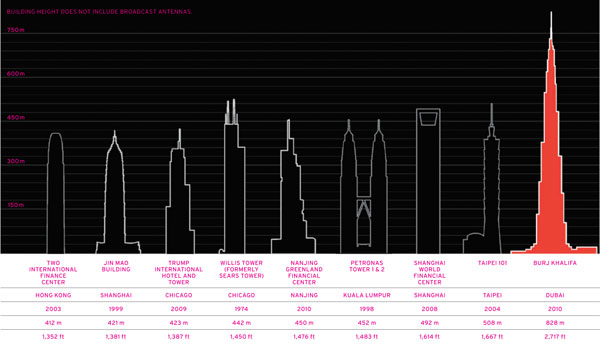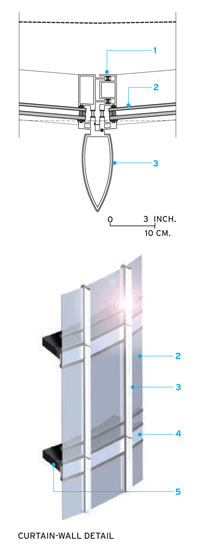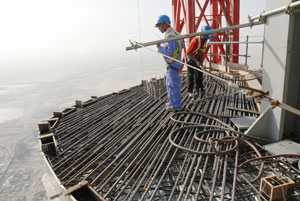Beyond Limits
Seven two- to three-story-high mechanical floors are distributed throughout the building, about every 30 floors or so. "It's really a series of 30-story buildings stacked on top of one another," Baker says. "There would be too much pressure in the pipes, and ducts would get too big, if you try to move things too far."
» Click Here to Enlarge |
Â
The mechanical floors house various equipment, including water tanks and pumps, air-handling units, and electrical substations. Track-mounted building-maintenance units, used for window washing, are stored in garages within the structure. "We were very aware of the sand problem," Smith says. "The consistency of the sand in Dubai is more like talcum powder. It sticks to everything." The building was kept as flush as possible, and ledges were kept to a minimum to reduce the number of areas where sand could settle. Window washing is expected to take place every few months.
Over 26,000 low-E, antiglare glass panels were used in the exterior cladding of Burj Khalifa, which features more than 1.8 million square feet of glass. Eight-inch-long wing-shaped, stainless-steel mullions occur at every glass joint. "We originally designed the exterior wall with steel tubes, but it looked too industrial," recalls Smith. "The sheen of the vertical stainless steel, especially in the horizontal sun of morning and evening, makes the building sing."
 |
Curtain-Wall Detail 1 aluminum vertical mullion |
 |
|
The tower used over 430,000 cubic yards of concrete and 43,000 tons of steel rebar. To help determine the concrete-to-rebar ratio, three-dimensional finite-element analysis models were used to predict the effects of creep and shrinkage. Photo © Samar Jodha/Spectra Maxima |
Â
While the building's structure and its exterior, including the cladding, were designed to resist a variety of forces, forces of a different kind needed to be addressed inside the tower. According to SOM's Luke Leung, "There is a tremendous amount of pressure in a building of this height, both on the water side and on the air side."
The typical system pressure for water is 300 psi. The Burj has one of the highest water pressures in the world at up to 460 psi. "Imagine a water pipe that is 800 meters tall," says Leung. "You don't want to be standing under that."
Pressure breaks are typically added in high-rise buildings to alleviate the forces. In the Burj, SOM created some of the highest pressure breaks ever in a building, consisting mainly of heat exchangers to isolate one riser from another. The tower's water system supplies an average of 250,000 gallons of water daily.









